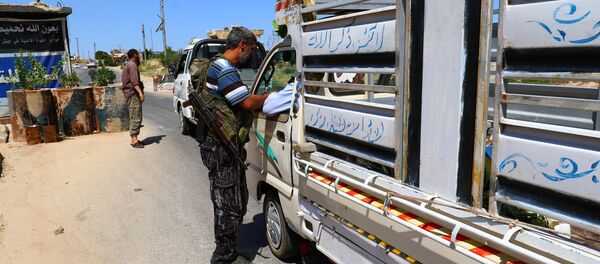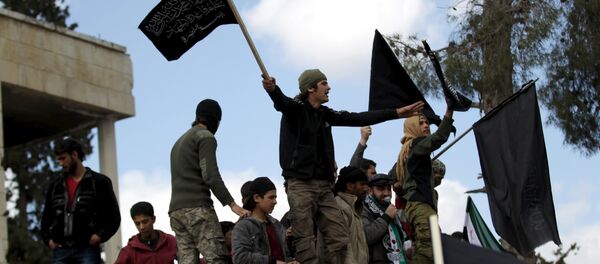The US, Russia and United Nations all designate al-Nusra Front, also known as al-Qaeda in Syria, a terrorist organization. But for some reason, the terror group's fighters appear "to be deeply entrenched alongside these US-backed militias in key, strategic towns and villages scattered throughout" the southern part of Syria, The American Conservative reported Sunday.
"US media and think tanks obfuscate this fact by referring to all opposition fighters as ‘rebels' or ‘moderates,'" the report notes.
The terror group has operated under other names, including Tahrir al-Sham, yet has not changed its pro-al-Qaeda orientation.
According to the report, the Nusra Front is "openly fighting" with the so-called "Southern Front." The Southern Front is "a group of 54 opposition militias funded and commanded by a US-led war room based in Amman, Jordan, called the Military Operations Center (MOC)" the article revealed.
The MOC provides intelligence, financing, weapons, individual salaries and training to each and every one of the 54 militias. While acknowledging the specifics about the US-led war room in Jordan are sparse, the American Conservative cites sources within Syria to support the assertion that the US is not alone in its support for violent militias in Syria. One detail in the report states that MOC was established in February 2014.
The US-aligned Free Syrian Army is reportedly in cahoots with the Nusra Front, whereby the the Nusra Front will operate alongside the FSA. "They offer their services and cooperate with us, they are better armed than we are, they have suicide bombers and know how to make car bombs," an FSA fighter told The National in 2014.
Even more interesting, the FSA relies on the Nusra Front to carry out offensives under the guise of being FSA combatants, which are more well-received in the international community. "In many battles al-Nusra takes part, but we don't tell the operations room [MOC, that is] about it and sometimes we'll even say that al-Nusra fighters are really from the FSA to enable them to move more easily across borders," one FSA commander told The National.
Not more than 6 months ago, in March, Trump exclaimed, "I want to get out, I want to bring our troops back home" at a news conference with the heads of state from Lithuania, Latvia and Estonia, Politico reported. The president also hinted that the US may be doing Saudi Arabia's bidding in Syria. "Saudi Arabia is very interested in our decision," Trump said. "And I said, ‘Well, you know, you want us to stay? Maybe you're going to have to pay.'"
At a rally among Trump supporters in late March, the American president vowed that "we'll be coming out of Syria, like, very soon. Let the other people take care of it."
At least one reason why the US media won't report on the cooperation between US-backed forces and the Nusra Front is that the United Nations Security Council, to which the US is a permanent representative, passed Resolution 2254 in 2015. That resolution declares that ceasefires "will not apply to offensive or defensive actions against" Daesh (ISIS), Nusra Front, "and all other individuals, groups, undertakings, and entities associated" with these or any other terror group.
"This essentially means that the Syrian army and its allies can tear apart any areas in the south of Syria where Nusra fighters — and "entities associated" with it — are based. In effect, international law provides a free hand for a Syrian military assault against US-backed militias co-located with Nusra, and undermines the ability of their foreign sponsors to take retaliatory measures," The American Conservative reported.
"It's no wonder we're having a tough time fighting the terrorists when there's still so much confusion over who they are," Max Abrahms, a professor at Northeastern University and member of the Council on Foreign Relations, wrote in an article appearing in the LA Times November 8.





